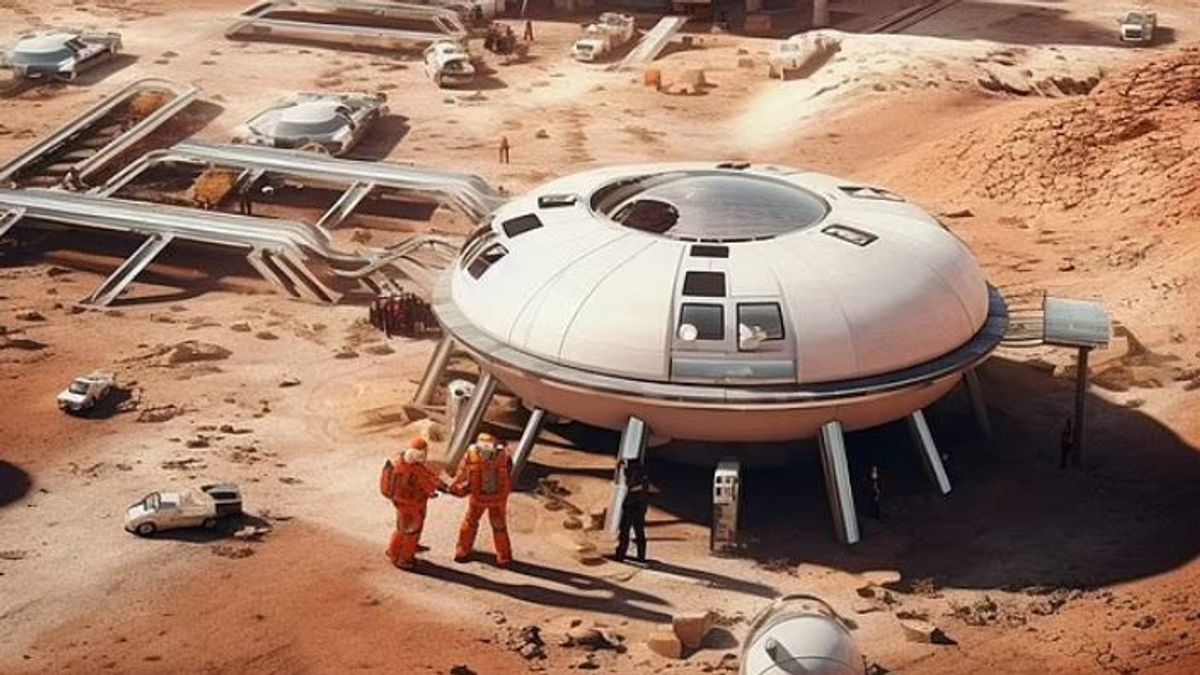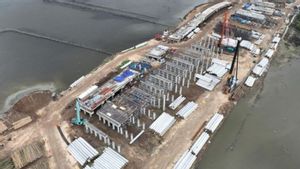JAKARTA - From science fiction films such as Interstellar to The Martian, space exploration by humans has always been an important element in these films. However, what exactly is a human colony in real life?
Space experts claim that human exploration in space will begin with a 'tainaut' that builds a 'gate' near Earth.
According to them, this gate will help a small number of human explorers build settlements on the moon and then on Mars.
To imagine what the settlement would look like, DailyMail.com uses a popular AI art generator called Midjourney to create images of the space colony and spacecraft based on this prediction.
Gates Near Earth
"Human exploration will depend on 'gates' and 'clouds' autonomous in space that will take human explorers to Mars and other places," said David Barnhart, CEO and founder of space company Arkisys.
"The future of human exploration will depend on how well we can build the necessary infrastructure, such as supply chains, housing and food stores," Barnhart said in an interview with DailyMail.com.
According to Barnhart, as is the case on Earth, outer space will be explored by the pioneers, who will build the necessary infrastructure so that more people can follow suit.
"Eksplorasi di Bumi terjadi dalam beberapa dekade, tetapi hampir selalu dimulai oleh para piliir dan kemudian diikuti dengan pembangunan fort, kota, desa, dan sebagainya yang dapat menerima barang/jasa yang diperlukan untuk pertumbuhan, dan dengan demikian memungkinkan lebih banyak manusia untuk diangkutan," ungkapnya.
Arkisys aims to build 'The Port' - a beacon and a barrier orbiting and serving travelers and spacecraft in Earth's orbits, moons, Mars, and other places.
Space Station orbits The Moon
NASA's initial concept for sustainable settlements on the Moon is the establishment of a "Gateway", which aims to help transfer fuel and personnel from/to the surface, but also serves as a stopping station for possible transport to Mars, Barnhart said.
"Currently there is a boost from both the government and the private sector to develop various levels of infrastructure, ranging from space stations or full-scale settlements, to autonomous "Ports" that can be improved," he explained.
Barnhart points out that Morgan Stanley has predicted that the space sector could be worth up to 1.1 trillion dollars (IDR 16,358 trillion) by 2040.
Mining Asteroids
The asteroid mining is one of the potentially profitable industries, with Neil Degrasse Tyson proposing that the first trillioner to become the king of asteroid mining.
Asterank measures the potential value of more than 6,000 asteroids monitored by NASA and states that only 10 asteroids were selected for their proximity to Earth could generate a profit of 1.5 trillion dollars (23 quadrillion).
One of the asteroids, 16 Psyche, is estimated to have gold worth 700 quadrillion dollars.
Berakik Lunar Base
"Basis-basis on the Moon and a space station near Earth will be inhabited by the 'tainauts' who built the first infrastructure in space," said former NASA consultant Philip Robert Harris.
In his book entitled "Space Enterprise: Living and Working Offworld in the 21st Century," he wrote: "The construction of a space station and a base on the Moon will form the basis of space infrastructure for the next fifty years, which will lead to further space settlements, manned missions to Mars, asteroid mining, and finally the establishment of a human colony orbiting in space or on other planets."
"Starting from a group of astronauts and cosmonauts, which is then expanded with space construction workers or technauts, the human population there is likely to increase to thousands of space people during this millennial," he explained.
In the book, former NASA expert David G. Schrunk added: "Moon is a logical place to establish the first human settlement in space. The moon offers protection from the dangers of outer space, has energy resources (soil light) and materials that can be used to support human activity, and is an excellent platform for scientific research, especially astronomy."
Spaceships To Mars
Elon Musk has made various predictions about his trip to Mars, with last year's suggestion that a human trip to a red planet may be possible by 2029.
Musk hopes to use a Starship rocket that can be reused to lower costs, with a Starship fleet "serving" interplanetary travel.
Travel advocates to Mars such as Robert Zubrin suggested that "golding sufficient goods" could keep Mars' exploration costs minimal, and Mars exploration could open up mining opportunities and breakthroughs to new technologies.
"For life to become multiplanets, we will probably need about 1,000 ships, or something like that," Musk said, one time.
Permanent Base on Mars
Musk believes that becoming a extraterrestrial civilization will help humanity avoid "filters" where there is a danger of extinction from events such as nuclear warfare.
"If we are able to make life sustainable on Mars, we will pass through one of the largest filters. This will pave the way for us to become interstellar," he explained.
"The Earth is about 4.5 billion years old, but life is still not multiplanetary and it is very uncertain how long it is left to achieve this. In the long term, it is very important to maintain the light of awareness. In the end, something will happen to Earth, hopefully not immediately, whether it is a natural disaster or man-made, which can lead to the end of civilization. The hope of the sustainability of civilization is much greater if we become a multiplanetary species," Musk said.
Hi-Tech Orbiters Designed By Artificial Intelligence
"The future space habitat will be built using hi-tech materials using robotics and artificial intelligence," said Vivek Koncherry, CEO of Graphene Space Habitat Limited based at the Graphene Engineering Innovation Center at the University of Manchester.
The Koncherry team has produced a 3D scale model of the space habitat, and hopes to build a manufacturing unit to create a space habitat. The space habitat will use a composite enriched with graphene.
"Graphene is a fantastic solution because it is lighter than the metal previously used in space habitat, and is a very good heat emitter, so it can be used to remove heat in the hottest conditions," Koncherry told DailyMail.com.
"We know that our structure will not be perfect at all times, but we can make estimates based on knowledge, make small prototypes, and send them into space with sensors," he added.
"I'm not saying everything will work perfectly from the start - some components can and will fail. But if you want fast research, the only way is to make things quickly, test them, get data, and learn from those experiences," he concluded.
The English, Chinese, Japanese, Arabic, and French versions are automatically generated by the AI. So there may still be inaccuracies in translating, please always see Indonesian as our main language. (system supported by DigitalSiber.id)












